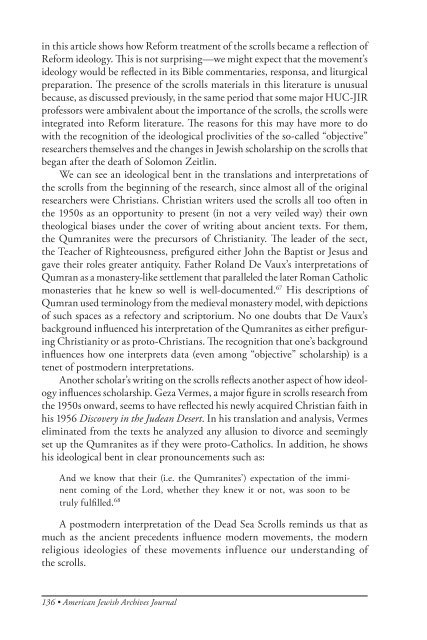The American Jewish Archives Journal, Volume LXI 2009, Number 1
The American Jewish Archives Journal, Volume LXI 2009, Number 1
The American Jewish Archives Journal, Volume LXI 2009, Number 1
You also want an ePaper? Increase the reach of your titles
YUMPU automatically turns print PDFs into web optimized ePapers that Google loves.
in this article shows how Reform treatment of the scrolls became a reflection of<br />
Reform ideology. This is not surprising—we might expect that the movement’s<br />
ideology would be reflected in its Bible commentaries, responsa, and liturgical<br />
preparation. <strong>The</strong> presence of the scrolls materials in this literature is unusual<br />
because, as discussed previously, in the same period that some major HUC-JIR<br />
professors were ambivalent about the importance of the scrolls, the scrolls were<br />
integrated into Reform literature. <strong>The</strong> reasons for this may have more to do<br />
with the recognition of the ideological proclivities of the so-called “objective”<br />
researchers themselves and the changes in <strong>Jewish</strong> scholarship on the scrolls that<br />
began after the death of Solomon Zeitlin.<br />
We can see an ideological bent in the translations and interpretations of<br />
the scrolls from the beginning of the research, since almost all of the original<br />
researchers were Christians. Christian writers used the scrolls all too often in<br />
the 1950s as an opportunity to present (in not a very veiled way) their own<br />
theological biases under the cover of writing about ancient texts. For them,<br />
the Qumranites were the precursors of Christianity. <strong>The</strong> leader of the sect,<br />
the Teacher of Righteousness, prefigured either John the Baptist or Jesus and<br />
gave their roles greater antiquity. Father Roland De Vaux’s interpretations of<br />
Qumran as a monastery-like settlement that paralleled the later Roman Catholic<br />
monasteries that he knew so well is well-documented. 67 His descriptions of<br />
Qumran used terminology from the medieval monastery model, with depictions<br />
of such spaces as a refectory and scriptorium. No one doubts that De Vaux’s<br />
background influenced his interpretation of the Qumranites as either prefiguring<br />
Christianity or as proto-Christians. <strong>The</strong> recognition that one’s background<br />
influences how one interprets data (even among “objective” scholarship) is a<br />
tenet of postmodern interpretations.<br />
Another scholar’s writing on the scrolls reflects another aspect of how ideology<br />
influences scholarship. Geza Vermes, a major figure in scrolls research from<br />
the 1950s onward, seems to have reflected his newly acquired Christian faith in<br />
his 1956 Discovery in the Judean Desert. In his translation and analysis, Vermes<br />
eliminated from the texts he analyzed any allusion to divorce and seemingly<br />
set up the Qumranites as if they were proto-Catholics. In addition, he shows<br />
his ideological bent in clear pronouncements such as:<br />
And we know that their (i.e. the Qumranites’) expectation of the imminent<br />
coming of the Lord, whether they knew it or not, was soon to be<br />
truly fulfilled. 68<br />
A postmodern interpretation of the Dead Sea Scrolls reminds us that as<br />
much as the ancient precedents influence modern movements, the modern<br />
religious ideologies of these movements influence our understanding of<br />
the scrolls.<br />
136 • <strong>American</strong> <strong>Jewish</strong> <strong>Archives</strong> <strong>Journal</strong>

















